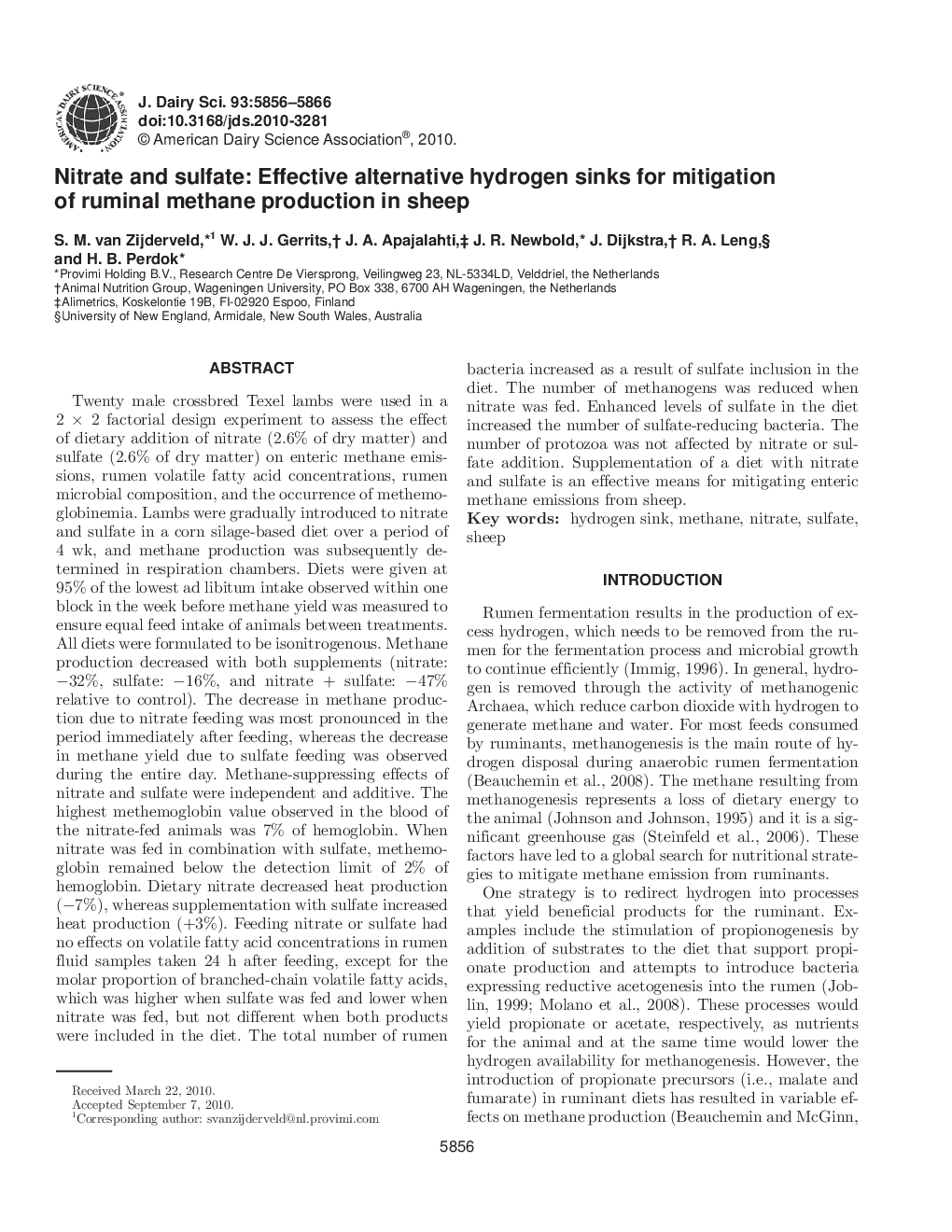| کد مقاله | کد نشریه | سال انتشار | مقاله انگلیسی | نسخه تمام متن |
|---|---|---|---|---|
| 10979226 | 1108062 | 2010 | 11 صفحه PDF | دانلود رایگان |
عنوان انگلیسی مقاله ISI
Nitrate and sulfate: Effective alternative hydrogen sinks for mitigation of ruminal methane production in sheep
دانلود مقاله + سفارش ترجمه
دانلود مقاله ISI انگلیسی
رایگان برای ایرانیان
موضوعات مرتبط
علوم زیستی و بیوفناوری
علوم کشاورزی و بیولوژیک
علوم دامی و جانورشناسی
پیش نمایش صفحه اول مقاله

چکیده انگلیسی
Twenty male crossbred Texel lambs were used in a 2 à 2 factorial design experiment to assess the effect of dietary addition of nitrate (2.6% of dry matter) and sulfate (2.6% of dry matter) on enteric methane emissions, rumen volatile fatty acid concentrations, rumen microbial composition, and the occurrence of methemoglobinemia. Lambs were gradually introduced to nitrate and sulfate in a corn silage-based diet over a period of 4 wk, and methane production was subsequently determined in respiration chambers. Diets were given at 95% of the lowest ad libitum intake observed within one block in the week before methane yield was measured to ensure equal feed intake of animals between treatments. All diets were formulated to be isonitrogenous. Methane production decreased with both supplements (nitrate: â32%, sulfate: â16%, and nitrate + sulfate: â47% relative to control). The decrease in methane production due to nitrate feeding was most pronounced in the period immediately after feeding, whereas the decrease in methane yield due to sulfate feeding was observed during the entire day. Methane-suppressing effects of nitrate and sulfate were independent and additive. The highest methemoglobin value observed in the blood of the nitrate-fed animals was 7% of hemoglobin. When nitrate was fed in combination with sulfate, methemoglobin remained below the detection limit of 2% of hemoglobin. Dietary nitrate decreased heat production (â7%), whereas supplementation with sulfate increased heat production (+3%). Feeding nitrate or sulfate had no effects on volatile fatty acid concentrations in rumen fluid samples taken 24 h after feeding, except for the molar proportion of branched-chain volatile fatty acids, which was higher when sulfate was fed and lower when nitrate was fed, but not different when both products were included in the diet. The total number of rumen bacteria increased as a result of sulfate inclusion in the diet. The number of methanogens was reduced when nitrate was fed. Enhanced levels of sulfate in the diet increased the number of sulfate-reducing bacteria. The number of protozoa was not affected by nitrate or sulfate addition. Supplementation of a diet with nitrate and sulfate is an effective means for mitigating enteric methane emissions from sheep.
ناشر
Database: Elsevier - ScienceDirect (ساینس دایرکت)
Journal: Journal of Dairy Science - Volume 93, Issue 12, December 2010, Pages 5856-5866
Journal: Journal of Dairy Science - Volume 93, Issue 12, December 2010, Pages 5856-5866
نویسندگان
S.M. van Zijderveld, W.J.J. Gerrits, J.A. Apajalahti, J.R. Newbold, J. Dijkstra, R.A. Leng, H.B. Perdok,